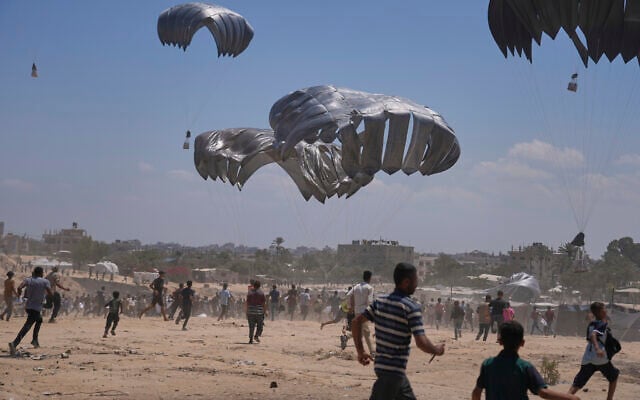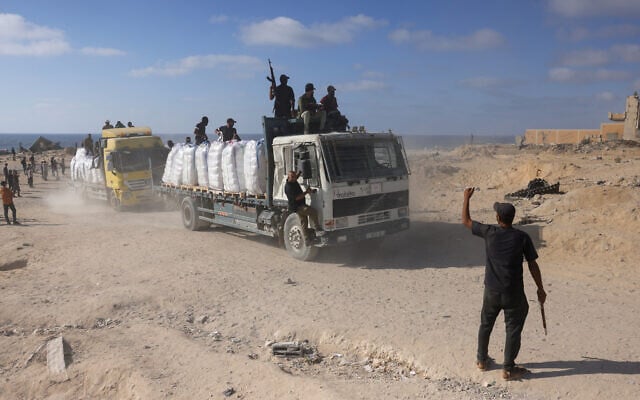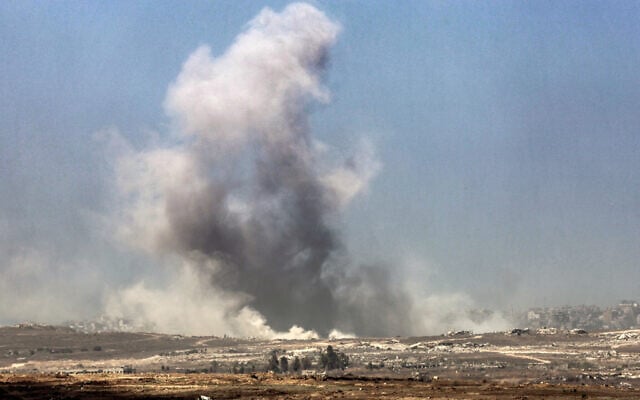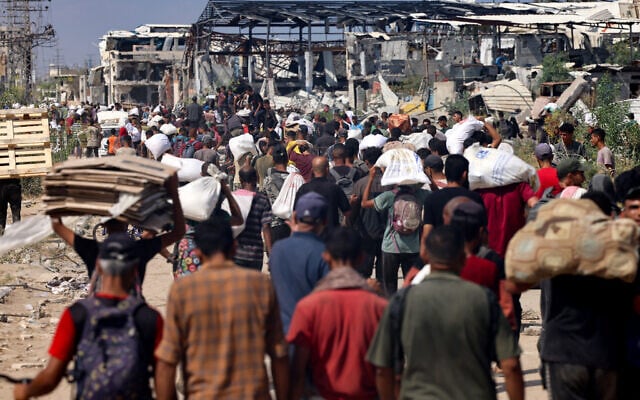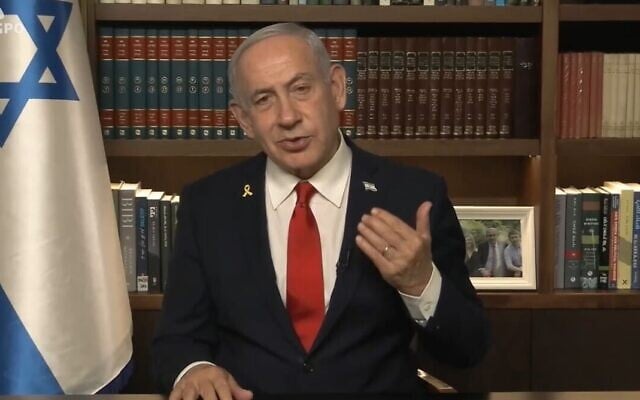



Israel will gradually permit the entry of goods into the Gaza Strip through the private sector for the first time in almost a year, the government’s liaison to the Palestinians announced Tuesday, adding another channel for supplies to arrive alongside the aid organizations already operating.
The Defense Ministry’s Coordinator of Government Activities in the Territories (COGAT) said the move aimed to “increase the volume of aid entering the Gaza Strip, while reducing reliance on aid collection by the United Nations and international organizations.”
The announcement, which was criticized by hawkish groups and politicians, came as the UN admitted that 88 percent of the aid trucks it has collected over the past few months did not reach their destination due to looting or theft.
Meanwhile, the Israel Defense Forces said an officer was moderately wounded Tuesday by an explosive device during operations in the southern Gaza Strip, adding that he was taken to a hospital for treatment and his family was notified.
The IDF also said troops had hit dozens of targets in Gaza, including destroying some of Hamas’s tunnels under the coastal enclave, which are a key part of its military strategy.
Images of apparently starving Palestinians, including children, have alarmed the world in recent weeks, ramping up international pressure on Israel to enable more aid into the coastal enclave where war has been raging since the devastating Hamas-led attack on Israel on October 7, 2023.
Israel says that Hamas steals supplies from deliveries by the UN and international aid groups. The US- and Israel-backed Gaza Humanitarian Foundation (GHF), established to provide aid via an alternative that would keep goods out of Hamas’s hands, has been plagued by near-daily shooting incidents that have seen hundreds killed as they try to reach the GHF distribution centers.
“As part of formulating this mechanism, a limited number of local merchants were approved by the defense establishment, subject to specific criteria and thorough security screening,” COGAT said in its announcement of the plan to use the commercial sector.
It said the approved goods include basic food products, baby food, fruits and vegetables, and hygiene supplies and “payments for the purchase of these goods will be conducted via bank transfers only, under a monitoring and oversight mechanism.”
The goods will undergo an inspection by Israeli authorities at the border crossings with Gaza before entering the Strip.
In the past year, only aid supplied by the UN or other international humanitarian organizations has been permitted to enter Gaza.
“The IDF, through COGAT, and in cooperation with security agencies, will continue to operate monitoring and oversight mechanisms for the entry of aid into the Gaza Strip, while taking all possible measures to prevent the involvement of the Hamas terrorist organization in the processes of bringing in and distributing the aid,” the COGAT statement continued.
Israel previously allowed goods into Gaza via the private sector between May and October 2024.
In a November 2024 response to a High Court appeal by human rights groups, COGAT said that “verified indications show that the Hamas terror organization is exploiting the entry of goods for economic and military buildup.” It was therefore decided on October 8, 2024, not to allow the continued entry of goods into the Strip via the private sector.
Tzav 9, a right-wing group lobbying against aid to Gaza until the Hamas terror group frees the remaining hostages, panned the development as another “vile blood reward” for Hamas and warned that it would reestablish a method that the group exploited in the past to build its military. The Israeli military has also previously asserted that Hamas was diverting aid from private sector deliveries.
The group said that the new proposed method for delivering aid is “exactly the same way by which materials entered Gaza that Hamas used to build itself up for the slaughter” of October 7, 2023, when the Palestinian terror group led over 5,000 terrorists to invade southern Israel, killing 1,200 people, and taking 251 as hostages to Gaza, triggering the war.
“You have completely lost it,” the group wrote, addressing the government’s ministers while noting that they bear full responsibility for the decision.
Opposition MK Avigdor Liberman, who leads the hawkish Yisrael Beytenu party, also criticized the COGAT decision, saying in a post on X that it would amount to “direct funding of the terrorists.”
Liberman noted that the private sector pays taxes to Hamas and accused the government of “funding Hamas while our hostages are languishing in the tunnels.”
Israel’s concerns over what happens to UN aid deliveries appeared to be reinforced as the global body admitted that nearly all supplies it took charge of failed to be delivered as planned.
The United Nations Office for Project Services published data showing that since the resumption of humanitarian aid deliveries to Gaza on May 19 and up until August 5, a total of 2,604 aid trucks were collected by the UN. Of those, 2,309 did not reach their intended destinations inside the Gaza Strip. According to the organization, this was due to the trucks being “intercepted either peacefully by hungry people or forcefully by armed actors during transit in Gaza.”
The numbers account for 88 percent of all trucks. In recent months, the percentages were even higher. According to UNOPS, in June, 1,155 trucks were collected by the UN and its partner organizations after crossing into Gaza, and 1,048 of them — 90.7% — were intercepted before reaching their destinations. In July, the figure rose to 94%, with 1,161 trucks collected and 1,093 intercepted.
In an update about its operations in Gaza, the IDF said Tuesday morning that it had shelled dozens of terror targets in the Gaza Strip with artillery over the previous 24 hours.
In southern Gaza, the IDF said the 282nd Artillery Regiment hit over 30 targets, including buildings and apartments used by Hamas to advance attacks on troops in the area.
The 990th Reserve Artillery Regiment killed several terror operatives and hit additional buildings used by terror groups in northern Gaza, the army said.
Hamas authorities reported Monday that over 90 people were killed in Israeli strikes in Gaza over the previous 24 hours.
Also in southern Gaza, the 188th Armored Brigade destroyed a building where the IDF said it located a tunnel entrance and killed operatives who approached the forces.
Tunnels were also demolished during operations of the Givati Brigade in northern Gaza’s Beit Hanoun, the IDF added.
Humanitarian groups continue to sound the alarm over widespread starvation in Gaza and increasing reports of deaths due to malnutrition. The United Nations says more than 1,300 people have been killed trying to obtain aid supplies in the enclave since the GHF began operating in May, most of them shot by Israeli forces operating near GHF sites.
The IDF has acknowledged firing warning shots at crowds that get too close to its soldiers, but called the UN tallies exaggerated, though it hasn’t provided alternate numbers.
Israel, in response to a rising international uproar, announced last week steps to let more aid reach Gaza, including pausing fighting for part of the day in some areas, approving air drops by foreign nations, and announcing protected routes for aid convoys.
The GHF began operating in May after a nearly three-month aid blockade Israel had imposed on the Strip. The group seeks to circumvent Hamas in the distribution of aid, amid Israeli allegations that the terror group regularly hijacks deliveries under the existing UN-led aid system. The UN and other aid groups have rejected the GHF, accusing it of violating humanitarian principles of neutrality and of putting aid seekers in harm’s way.
Meanwhile, five more people died of starvation or malnutrition over the past 24 hours, Gaza’s Hamas-run health ministry said on Monday evening. The new deaths raised the toll of those dying from hunger to 180, including 93 children, since the war began. Hamas figures cannot be verified, and the group does not distinguish between civilians and fighters.
Israel has denied allegations of widespread starvation in Gaza and blamed the UN and Hamas for obstructing or diverting aid meant for civilians.
The next phase of the war remains unclear. Prime Minister Benjamin Netanyahu is said to be leaning towards expanding military operations for a full takeover of Gaza, a move that his right flank supports. However, some ministers reportedly oppose the idea, as does IDF Chief of Staff Lt. Gen. Eyal Zamir.
Government critics are urging Israel to reach a ceasefire deal with Hamas to end the war and free all the hostages, of whom 50 remain in captivity, only 20 still believed alive and in dangerously poor health.
Netanyahu insisted on Sunday that Hamas is uninterested in a deal, which creates an incentive to “destroy” the terror group.
Negotiations between the sides reached an impasse in late July. But pressure on the government to free the hostages has remained heavy following the publication last week of videos showing two of the captives, Rom Braslavski and Evyatar David, in emaciated condition.


